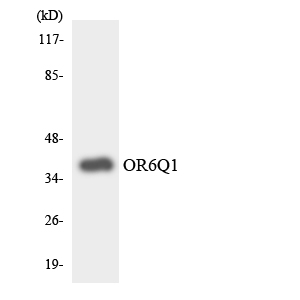Olfactory receptor 6Q1 Polyclonal Antibody
- Catalog No.:YT3431
- Applications:WB;IF;ELISA
- Reactivity:Human
- Target:
- Olfactory receptor 6Q1
- Fields:
- >>Olfactory transduction
- Gene Name:
- OR6Q1
- Protein Name:
- Olfactory receptor 6Q1
- Human Gene Id:
- 219952
- Human Swiss Prot No:
- Q8NGQ2
- Immunogen:
- The antiserum was produced against synthesized peptide derived from human OR6Q1. AA range:23-72
- Specificity:
- Olfactory receptor 6Q1 Polyclonal Antibody detects endogenous levels of Olfactory receptor 6Q1 protein.
- Formulation:
- Liquid in PBS containing 50% glycerol, 0.5% BSA and 0.02% sodium azide.
- Source:
- Polyclonal, Rabbit,IgG
- Dilution:
- WB 1:500 - 1:2000. IF 1:200 - 1:1000. ELISA: 1:20000. Not yet tested in other applications.
- Purification:
- The antibody was affinity-purified from rabbit antiserum by affinity-chromatography using epitope-specific immunogen.
- Concentration:
- 1 mg/ml
- Storage Stability:
- -15°C to -25°C/1 year(Do not lower than -25°C)
- Other Name:
- OR6Q1;Olfactory receptor 6Q1;Olfactory receptor OR11-226
- Observed Band(KD):
- 36kD
- Background:
- Olfactory receptors interact with odorant molecules in the nose, to initiate a neuronal response that triggers the perception of a smell. The olfactory receptor proteins are members of a large family of G-protein-coupled receptors (GPCR) arising from single coding-exon genes. Olfactory receptors share a 7-transmembrane domain structure with many neurotransmitter and hormone receptors and are responsible for the recognition and G protein-mediated transduction of odorant signals. The olfactory receptor gene family is the largest in the genome. The nomenclature assigned to the olfactory receptor genes and proteins for this organism is independent of other organisms. This olfactory receptor gene is a segregating pseudogene, where some individuals have an allele that encodes a functional olfactory receptor, while other individuals have an allele encoding a
- Function:
- function:Odorant receptor .,polymorphism:A single nucleotide deletion at position Leu-229 in the gene coding for this protein is responsible for functional diversity thus producing a pseudogene. The deletion is more frequent in African-Americans than in non-Africans.,similarity:Belongs to the G-protein coupled receptor 1 family.,
- Subcellular Location:
- Cell membrane; Multi-pass membrane protein.
- June 19-2018
- WESTERN IMMUNOBLOTTING PROTOCOL
- June 19-2018
- IMMUNOHISTOCHEMISTRY-PARAFFIN PROTOCOL
- June 19-2018
- IMMUNOFLUORESCENCE PROTOCOL
- September 08-2020
- FLOW-CYTOMEYRT-PROTOCOL
- May 20-2022
- Cell-Based ELISA│解您多样本WB检测之困扰
- July 13-2018
- CELL-BASED-ELISA-PROTOCOL-FOR-ACETYL-PROTEIN
- July 13-2018
- CELL-BASED-ELISA-PROTOCOL-FOR-PHOSPHO-PROTEIN
- July 13-2018
- Antibody-FAQs
- Products Images

- Western Blot analysis of Jurkat cells using Olfactory receptor 6Q1 Polyclonal Antibody diluted at 1:1000

- Western blot analysis of lysates from Jurkat and HT-29 cells, using OR6Q1 Antibody. The lane on the right is blocked with the synthesized peptide.

- Western blot analysis of the lysates from HT-29 cells using OR6Q1 antibody.



